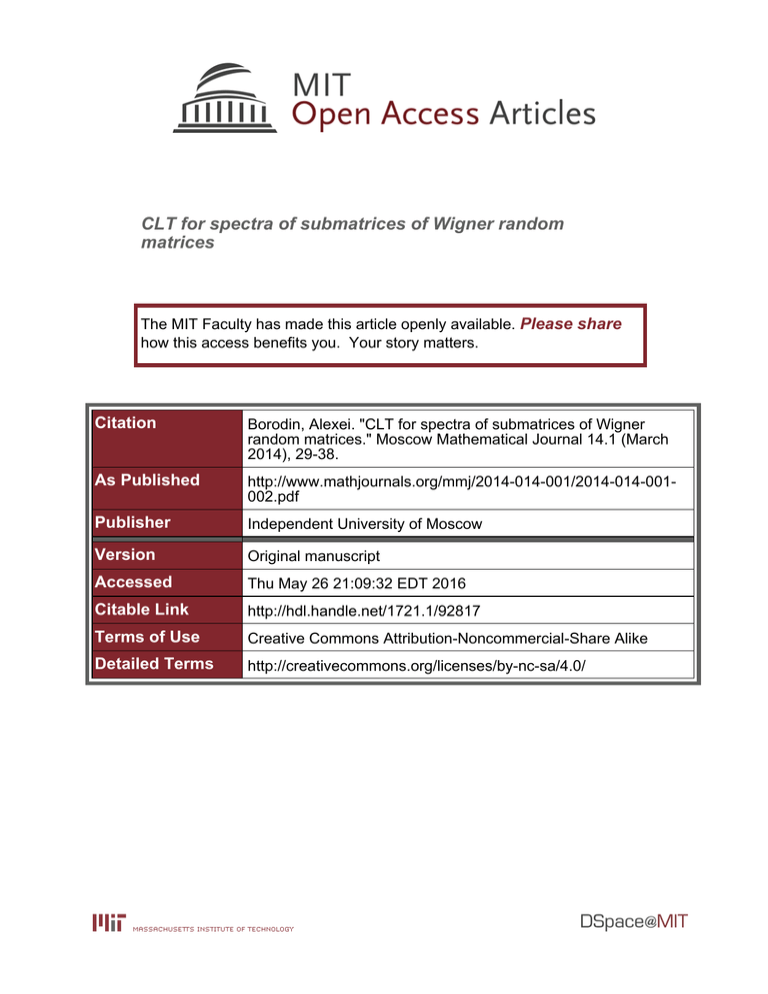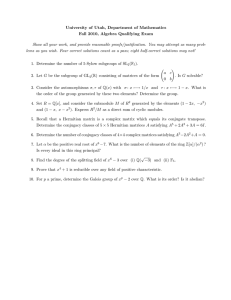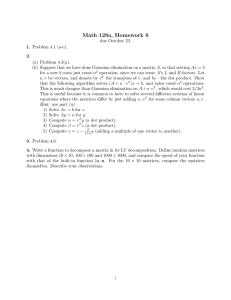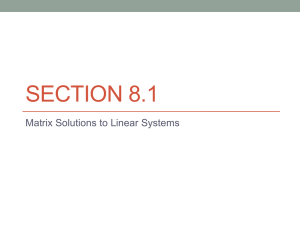CLT for spectra of submatrices of Wigner random matrices Please share
advertisement

CLT for spectra of submatrices of Wigner random
matrices
The MIT Faculty has made this article openly available. Please share
how this access benefits you. Your story matters.
Citation
Borodin, Alexei. "CLT for spectra of submatrices of Wigner
random matrices." Moscow Mathematical Journal 14.1 (March
2014), 29-38.
As Published
http://www.mathjournals.org/mmj/2014-014-001/2014-014-001002.pdf
Publisher
Independent University of Moscow
Version
Original manuscript
Accessed
Thu May 26 21:09:32 EDT 2016
Citable Link
http://hdl.handle.net/1721.1/92817
Terms of Use
Creative Commons Attribution-Noncommercial-Share Alike
Detailed Terms
http://creativecommons.org/licenses/by-nc-sa/4.0/
CLT FOR SPECTRA OF SUBMATRICES
arXiv:1010.0898v1 [math.PR] 5 Oct 2010
OF WIGNER RANDOM MATRICES
Alexei Borodin
Abstract. We prove a CLT for spectra of submatrices of real symmetric and Hermitian Wigner matrices. We show that if in the standard normalization the fourth
moment of the off-digonal entries is GOE/GUE-like then the limiting Gaussian
process can be viewed as a collection of simply yet nontrivially correlated twodimensional Gaussian Free Fields.
Introduction. Gaussian global fluctuations of eigenvalues of GUE, GOE, Wigner
random matrices, and their generalizations is a well-studied subject, see e.g. Chapter 2 of [AGZ] and Chapter 9 of [BS] as well as references therein. One would
usually concentrate on studying the spectrum of the full matrix, but it comes as
no surprise that for large submatrices with a regular limiting behavior, the joint
fluctuations would still be Gaussian. We prove this fact by a slight modification of
the moment method presented in [AGZ].
It becomes more interesting when one looks at the limiting covariance structure.
In what follows we assume that in the standard normalization the fourth moment
of the off-diagonal entries of our matrices is the same as for GOE/GUE.
The first statement is that for such a (real symmetric or Hermitian) Wigner
matrix, the joint fluctuations of spectra of nested submatrices formed by cutting out
top left corners are described by the two-dimensional Gaussian Free Field (GFF),
see e.g. [S] for definitions and basic properties of GFFs.
Although this result seems to be new, the appearance of the GFF is also not too
surprising. Indeed, as was shown in [JN] and [OR], for GUE the eigenvalue ensemble
of nested matrices arises as a limit of random surfaces, and for random surfaces the
relevance of the GFF is widely anticipated, see [K], [BF] for rigorous results and
further references. One might argue however that the GFF interpretation simplifies
the description of the covariance in the one-matrix case, cf. Proposition 3 below.
The real novelty comes when one considers joint fluctuations for different nested
sequences of submatrices. For each of the nested sequences the fluctuations are
again described by the GFF. On the other hand, when different sequences have
nontrivial and asymptotically regular intersections, these GFFs are correlated, and
the exact form of the covariance kernel turns out to be simple. One could argue
that it is as simple as one could hope for.
The resulting Gaussian process unites a large family of mutually correlated
GFFs. Even for two GFFs the resulting Gaussian process seems to be new. An efficient description of the largest natural state space for this Gaussian process remains
an open problem.
Typeset by AMS-TEX
1
2
ALEXEI BORODIN
It is natural to ask how univeral the limiting process is. We believe that it also
arises in the world of random surfaces, although it is not a priori clear how to vary
the nested sequence there. The answer comes from representation theory — one
views random surfaces as originating from restricting suitable representations to
a maximal commutative subalgebra and then one varies that subalgebra. We will
address these models in a later publication.
Acknowledgements. The author is very grateful to Grigori Olshanski and Ofer
Zeitouni for valuable comments. The work was partially supported by NSF grant
DMS-1056390.
Wigner matrices. Let {Zij }j>i≥1 and {Yi }i≥1 be two families of independent
identically distributed real-valued random variables with zero mean such that for
any k ≥ 1
max(E|Z12 |k , E|Y1 |k ) < ∞.
Assume also that
EY12 = 2,
2
= 1,
EZ12
4
EZ12
= 3.
Define a (real symmetric) Wigner matrix X by
Zij , i < j,
X(i, j) = X(j, i) =
Yi , i = j.
An Hermitian variation of the same definiton is as follows: Let {Zij }j>i≥1 now be
complex-valued (i.i.d. mean zero) random variables with the same uniform bound
on all moments. Assume that
EY12 = 1,
E|Z12 |2 = 1,
E|Z12 |4 = 2.
Define an Hermitian Wigner matrix X by
Zij , i < j,
X(i, j) = X(j, i) =
Yi , i = j.
In the case when all the random variables Yi , Zij (or Yi , ℜZij , ℑZij in the Hermitian case) are Gaussian, the Wigner matrix is said to belong to the Gaussian
Orthogonal Ensemble (GOE) in the real case, and Gaussian Unitary Ensemble
(GUE) in the Hermitian case.
For any finite set B ⊂ {1, 2, . . . } we denote by X(B) the |B| × |B| submatrix of
the (real symmetric or Hermitian) Wigner matrix X formed by the intersections of
the rows and columns of X marked by elements of B. Clearly, the distribution of
X(B) depends only on |B|.
Traditionally one encodes the real symmetric and the Hermitian cases by a parameter β that takes value 1 for GOE and value 2 for GUE.
The height function. Let A = {an }n≥1 be an arbitrary sequence of pairwise
distinct natural numbers. The height function HA associated to A and a Wigner
matrix X is a random integer-valued function on R × R≥1 defined by
r
βπ the number of eigenvalues of X({a1 , . . . , a[y] }) that are ≥ x .
HA (x, y) =
2
p
The convenience of the constant prefactor βπ/2 will be evident shortly.
CLT FOR SPECTRA OF SUBMATRICES OF WIGNER RANDOM MATRICES
3
Good families of sequences. In what follows L > 0 is a large parameter.
Let {Ai }i∈I be a family of sequences of pairwise distinct natural numbers. Assume they all depend on L. Denote
Ai = {ai,n }n≥1 ,
Ai,m = {ai,1 , . . . , ai,m },
i ∈ I,
m ∈ N.
We say that {Ai }i∈I is a good family if for any i, j ∈ I and x, y ∈ R>0 there
exists a limit
Ai,[xL] ∩ Aj,[yL] .
α(i, x; j, y) = lim
L→∞
L
Here is an example of a good family: I = {1, 2, 3, 4} and
a1,n = n,
a2,n = 2n,
a3,n = 2n + 1,
a4,n
n + L, n ≤ L,
= n − L, L < n ≤ 2L,
n,
n > 2L.
Note, however, that the index set I does not have to be finite.
Correlated Gaussian Free Fields. Let {Ai }i∈I be a good family of sequences
as above. Take a family of copies of the upper half-plane H = {z ∈ C | ℑz > 0}
indexed by I and consider their union
H(I) =
[
Hi .
i∈I
Introduce a function C : H(I) × H(I) → R ∪ {−∞} via
α(i, |z|2 ; j, |w|2 ) − zw 1
,
ln
Cij (z, w) =
2π α(i, |z|2 ; j, |w|2 ) − zw i, j ∈ I,
z ∈ Hi , w ∈ Hj ,
where α( · ) is as above. Note that for i = j
Cii (z, w) =
min(|z|2 , |w|2 ) − zw 1
= − 1 ln z − w ln 2
2
2π
min(|z| , |w| ) − zw
2π
z − w
is the Green function for the Laplace operator on H with Dirichlet boundary conditions.
Proposition 1. For any good family of sequences as above, there exists a generalized Gaussian process on H(I) with the covaraince kernel C(z, w) as above. More
exactly, for any finite family of test functions fm (z) ∈ C0 (Him ) and i1 , . . . , iM ∈ I,
the covariance matrix
Z Z
fk (z)fl (w)Cik il (z, w) dzdz̄ dwdw̄,
k, l = 1, . . . , M,
cov(fk , fl ) =
H
H
is positive-definite.
Denote the resulting generalized Gaussian process by G{Ai }i∈I .
The proof of Propositon 1 will be given later.
4
ALEXEI BORODIN
Complex structure. Let A be a sequence of pairwise distinct integers. The height
function HA is naturally defined on R × R≥1 . Having the large parameter L, we
1
would like to scale (x, y) 7→ (L− 2 x, L−1 y), which lands us in R × R>0 .
1
Wigner’s semicircle law implies that with L ≫ 1, x ∼ L 2 , y ∼ L, after rescaling with overwhelming probability the eigenvalues (or, equivalently, the places of
growth of the height function in x-direction) are concentrated in the domain
√
√ (x, y) ∈ R × R>0 | −2 y ≤ x ≤ 2 y .
Let us identify the interior of this domain with H via the map
x
Ω : (x, y) 7→ + i
2
r
y−
x 2
2
.
Its inverse has the form
Ω−1 (z) = (x(z), y(z)) = (2ℜ(z), |z|2 ).
Note that this map sends the boundary of the domain to the real line.
Thanks to Ω we can now speak of the height function HA as being defined on
H; we will use the notation
1
Ω
HA
(z) = HA (L 2 x(z), Ly(z)),
z ∈ H.
Note that we have incorporated rescaling in this definition.
Main result. Let X be a (real symmetric or Hermitian) Wigner matrix. Let
{Ai }i∈I be a good family of sequences. We argue that the collection of the centralized random height functions
Ω
Ω
(zi ),
(zi ) − EHA
HA
i
i
i ∈ I,
zi ∈ Hi ,
viewed as distributions, converges as L → ∞ to the generalized Gaussian process
G{Ai }i∈I .
One needs to verify the convergence on a suitable set of test functions. The exact
statement that we prove is the following.
Theorem 2. Pick i ∈ I, y > 0, and k ∈ Z≥0 . Define a moment of the random
height function by
Mi,y,k =
Z
+∞
−∞
1
1
xk HAi (L 2 x, Ly) − EHAi (L 2 x, Ly) dx.
Then as L → ∞, these moments converge, in the sense of finite dimensional distributions, to the moments of G{Ai }i∈I defined as
Mi,y,k =
Z
z∈Hi
,|z|2 =y
(x(z))k G{Ai }i∈I (z)
dx(z)
dz.
dz
CLT FOR SPECTRA OF SUBMATRICES OF WIGNER RANDOM MATRICES
5
1
Moments as traces. Let us rescale the variable x = L− 2 u in the definition of
Mi,y,k and then integrate by parts. Since the derivative of the height function
HAi (u, [Ly]) in u is
d
HAi (u, [Ly]) = −
du
r
[Ly]
βπ X
δ(u − λs ),
2 s=1
where {λs }1≤s≤[Ly] are the eigenvalues of X(Ai,[Ly] ), we obtain
Mi,y,k = L−
k+1
2
r
[Ly] k+1
[Ly] k+1
X
X
λs
λs
βπ
−E
2
k
+
1
k
+1
s=1
s=1
r
k+1
L− 2
βπ
=
Tr X(Ai,[Ly] )k+1 − E Tr X(Ai,[Ly] )k+1 .
k+1
2
We can now reformulate the statement of Theorem 2 as follows.
Theorem 2’. Let X be a Wigner matrix. Let k1 , . . . , km ≥ 1 be integers, and
let B1 , . . . , Bm be subsets of N dependent on the large parameter L such that there
exists limits
|Bp ∩ Bq |
,
L→∞
L
|Bp |
> 0,
L→∞ L
cpq = lim
bp = lim
p, q = 1, . . . , m.
Then the m-dimensional random vector
k
m
kp
kp
− 2p
− E Tr X(Bp )
Tr X(Bp )
(1)
L
p=1
converges (in distribution and with all moments) to the zero mean m-dimensional
Gaussian random variable (ξp )m
p=1 with the covariance
(2) Eξp ξq
2kp kq
=
βπ
I
I
|z|2 =bp |w|2 =bq
ℑz>0 ℑw>0
kp −1
(x(z))
kq −1
(x(w))
cpq − zw dx(z) dx(w)
1
ln
dzdw.
2π cpq − zw dz
dw
Proof of Theorem 2’. The argument closely follows that given in Section 2.1.7
of [AGZ] in the case of one set Bj ≡ B. One proves the convergence of moments,
which is sufficient to also claim the convergence in distribution for Gaussian limits.
Any joint moment of the coordinates of (1) is written as a finite combination
of contributions corresponding to suitably defined graphs that are in their turn
associated to words. The only difference of the multi-set case with the one-set case
is that one needs to keep track of the alphabets these words are built from: A
word corresponding to coordinate number p of (1) would have to be built from the
alphabet that coincides with the set Bp . Equivalently, the corresponding graphs
will have their vertices labeled by elements of Bp .
6
ALEXEI BORODIN
Since all sizes |Bp | have order L, and |B1 ∪ · · · ∪ Bm | = O(L), the estimate
showing that all contributions not coming from matchings are negligible (Lemma
2.1.34 in [AGZ]) carries over without difficulty. It only remains to compute the
covariance.
For real symmetric Wigner matrices in the one-set case the limits of the variances
of the coordinates of (1) are given by (2.1.44) in [AGZ]. It reads (with k = kp for
a p between 1 and m)
2
(3)
2k 2 C 2k−1 + k 2 C 2k +
2
2
∞
X
2k 2
r
r=3
2
X
Pr ki ≥0
i=1 ki =k−r
r
Y
Cki ,
i=1
where {Ck }k≥1 are the Catalan numbers, and we assume Ca = 0 unless a ∈
{0, 1, 2, . . . }. The Catalan number Ck counts the number of rooted planar trees
with k edges, and different terms of (3) have the following interpretation (see [AGZ]
for detailed explanations):
• The first term comes from two trees with (k − 1)/2 edges each that hang from
a common vertex; the factor k 2 originates from choices of certain starting points
on each tree united with the common vertex, and the extra 2 is actually EY12 .
• The second term comes from two trees with k/2 edges each that are glued
along one edge. There are k/2 choices of this edge for each of the trees, there is an
4
additional 2 = EZ12
− 1, and another addional 2 responsible of the choice of the
orientation of the gluing.
• The third term comes from two graphs each of which is a cycle of length r
with pendant trees hanging off each of the vertices of the cycle; the total number of
edges in the extra trees being (k − r)/2 (this must be an integer). As for the first
term, there is an extra k 2 = k · k coming from the choice of the starting points and
also an extra 2 for the choice of the gluing orientation along the cycle.
For each of the three terms the total number of vertices in the resulting graph is
equal to k, and if one labels each vertex with a letter from an alphabet of cardinality
|B| this would yield a factor of
|B|(|B| − 1) · · · (|B| − k + 1) = |B|k + O(|B|k−1 ).
Normalization by |B|k yields (3).
In the general case, in order to evaluate the covariance
(4)
kp +kq
Tr X(Bq )kq − E Tr X(Bq )kq
L− 2 E Tr X(Bp )kp − E Tr X(Bp )kp
in the limit, we need to employ the same graph counting, except for the two graphs
being glued now correspond to different values kp and kq of k, and their vertices
are marked by letters of different alphabets Bp and Bq .
• The first term gives 2kp kq C kp −1 C kq −1 for the graph counting, and an extra
2
|Bp ∩ Bq | · (|Bp | − 1)(|Bp | − 2) · · · (|Bp | −
2
kp +1
kq +1
2 ) · (|Bq | − 1)(|Bq | − 2) · · · (|Bq | − 2 )
for the vertex labeling (the factor |Bp ∩ Bq | comes from the only common vertex).
Normalized by L−
kp +kq
2
this yields
kp −1
2
2kp kq C kp −1 C kq −1 cpq bp
2
2
kq −1
2
bq
.
CLT FOR SPECTRA OF SUBMATRICES OF WIGNER RANDOM MATRICES
kp
• The second term has kp kq C kp C kq from the graph counting and c2pq bp2
2
2
from the label counting; a total of
kp
kp kq C kp C kq c2pq bp2
2
−1
kq
bq2
−1
7
kq
bq2
−1
−1
2
• For the third term in the same way we obtain
∞
X
2kp kq
r
r=3
2
X
Pr si ≥0
i=1 si =kp −r
r
Y
Csi
i=1
2
X
Pr ti ≥0
i=1 ti =kq −r
r
Y
kp −r kq −r
Cti crpq bp 2 bq 2
i=1
Thus, the asymptotic value of the covariance (4) is
kp −1
2
2kp kq C kp −1 C kq −1 cpq bp
2
2
+
∞
X
2kp kq
r
r=3
2
kq −1
2
bq
X
Pr si ≥0
i=1 si =kp −r
kp
+ kp kq C kp C kq c2pq bp2
2 2
r
Y
Csi
i=1
2
X
−1
Pr ti ≥0
i=1 ti =kq −r
kq
bq2
r
Y
−1
kp −r kq −r
Cti crpq bp 2 bq 2
i=1
We now use the fact that for any S = 0, 1, 2, . . .
X
r
Y
i=1
Prsi ≥0
i=1 si =S
Csi
2S + r
r
=
,
2S + r
S
see (5.70) in [GKP]. This allows us to rewrite the asymptotic covariance in terms
of binomial coefficients:
kp −1 kq −1
kq
kp
cpq bp 2 bq 2
2
(kp − 1)/2 (kq − 1)/2
kp −2 kq −2
kq
kp
c2pq bp 2 bq 2
+4
kp /2 − 1 kq /2 − 1
∞
kp −r kq −r
X
kq
kp
crpq bp 2 bq 2
+
2r
(kp − r)/2 (kq − r)/2
r=3
∞
kp −r kq −r
X
kq
kp
crpq bp 2 bq 2
=
2r
(kp − r)/2 (kq − r)/2
r=1
Using the binomial theorem, we can write this expression as a double contour
integral
(5)
2
(2πi)2
ZZ
const1 =|z|<|w|=const2
k k
bp p
bq q cpq
dzdw
z+
.
w+
cpq
z
w
bp ( bp z − w)2
8
ALEXEI BORODIN
Consider the right-hand side of (2) and assume that |z|2 = bp < bq = |w|2 .
Observe that
cpq
z − w
cpq − zw b
p
= −2 ln c
2 ln bpq
cpq − zw z̄
−
w
p
cpq
cpq
cpq
cpq
z − w + ln
z − w̄ + ln
z̄ − w − ln
z̄ − w̄ .
= − ln
bp
bp
bp
bp
This allows us to rewrite the right-hand side of (2) as a double contour integral
over complete circles in the form
−
kp kq
2βπ 2
I
I
(x(z))kp −1 (x(w))kq −1 ln
|z|2 =bp |w|2 =bq
cpq
z−w
bp
dx(z) dx(w)
dzdw.
dz
dw
Recalling that β = 1 and noting that
kp (x(z))kp −1
dx(z)
d(x(z))kp
=
,
dz
dz
kq (x(w))kq −1
dx(w)
d(x(w))kq
=
,
dw
dw
we integrate by parts in z and w and recover (5). The proof for for bp = bq is
obtained by continuity of both sides, and to see that the needed identity holds for
bp > bq it suffices to observe that both sides are symmetric in p and q.
The argument in the case of Hermitian Wigner matrices is exactly the same,
except in the combinatorial part for the first term the factor 2 is missing due to the
change in EY12 , in the second term 2 is missing due to the change in E|Z12 |4 , and
in the third term 2 is missing because there is no choice in the orientation of two
r-cycles that are being glued together. Proof of Proposition 1. We need to show that for any complex numbers {uk }M
k=1
M
X
k,l=1
uk ul
Z Z
H
H
fk (z)fl (w)Cik il (z, w) dzdz̄ dwdw̄ ≥ 0.
We can approximate the integration over the two-dimensional domains by finite
sums of one-dimensional integrals over semi-circles of the form |z| = const. On
each semi-circle we further uniformly approximate the (continuous) integrand by
a polynomial in ℜ(z). Finally, for the polynomials the nonnegativity follows from
Theorem 2’. Chebyshev polynomials. One way to describe the limiting covariance structure
in the one-matrix case is to show that traces of the Chebyshev polynomials of
the matrix are asymptotically independent, see [J]. A similar effect takes place for
submatrices as well.
For n = 0, 1, 2, . . . let Tn (x) be the nth degree Chebyshev polynomial of the first
kind:
Tn (x) = cos(n arccos x),
Tn (cos(x)) = cos(nx).
For any a > 0, let Tna (x) = Tn ( xa ) be the rescaled version of Tn .
CLT FOR SPECTRA OF SUBMATRICES OF WIGNER RANDOM MATRICES
9
Proposition 3. In the assumptions of Theorem 2’, for any p, q = 1, . . . , m
"
√
√
2 bp Lkp
2 bp Lkp
(X(Bp )) − E Tr Tkp
(X(Bp ))
lim E Tr Tkp
L→∞
#
√
√
kp
2 bp Lkq
2 bq Lkq
= δkp kq
(X(Bq )) − E Tr Tkp
(X(Bq ))
× Tr Tkq
2β
cpq
p
bp bq
!kp
.
Proof. Using (5) and assuming bp < bq we obtain
"
√
√
2 bp Lkp
2 bp Lkp
(X(Bp )) − E Tr Tkp
(X(Bp ))
lim E Tr Tkp
L→∞
#
√
√
2 bq Lkq
2 bp Lkq
× Tr Tkq
(X(Bq )) − E Tr Tkp
(X(Bq ))
2
=
β(2πi)2
ZZ
Tkp (cos(arg(z))Tkq (cos(arg(w))
bp =|z|<|w|=bq
1
=
2β(2πi)2
ZZ
bp =|z|<|w|=bq
z
p
bp
kp
dzdw
cpq
cpq
bp ( bp z − w)2
p kp ! kq p kq !
bp
bq
w
p
+
+
z
w
bq
×
cpq
dzdw
.
cpq
bp ( bp z − w)2
c
z − w)−2 as a series in z/w we arrive at the result. Continuity and
Writing ( bpq
p
symmetry of both sides of the limiting relation removes the assumption bp < bq . References
[AGZ] G. W. Anderson, A. Guionnet, and O. Zeitouni, An introduction to random matrices,
Cambridge University Press, 2010.
[BS]
Z. Bai and J. W. Silverstein, Spectral analysis of large dimensional random matrices,
Springer, 2010.
[BF] A. Borodin and P. L. Ferrari, Anisotropic growth of random surfaces in 2+1 dimensions,
Preprint, 2008, arXiv:0804.3035.
[GKP] R. L. Graham, D. E. Knuth, and O. Patashnik, Concrete mathematics. A foundation for
computer science, Addison-Wesley Publishing Company, Reading, MA, 1994.
[J]
K. Johansson, On fluctuations of eigenvalues of random Hermitian matrices., Duke Math.
J. 91 (1998), no. 1, 151–204.
[JN]
K. Johansson and E. Nordenstam, Eigenvalues of GUE minors, Electron. J. Probab. 11
(2006), no. 50, 1342–1371.
[K]
R. Kenyon, Height fluctuations in the honeycomb dimer model, Comm. Math. Phys. 281
(2008), no. 3, 675–709.
[OR] A. Okounkov and N. Reshetikhin, The birth of a random matrix, Mosc. Math. J. 6 (2006),
no. 3, 553–566.
[S]
S. Sheffield, Gaussian free fields for mathematicians, Probab. Theory Related Fields 139
(2007), no. 3-4, 521–541.






